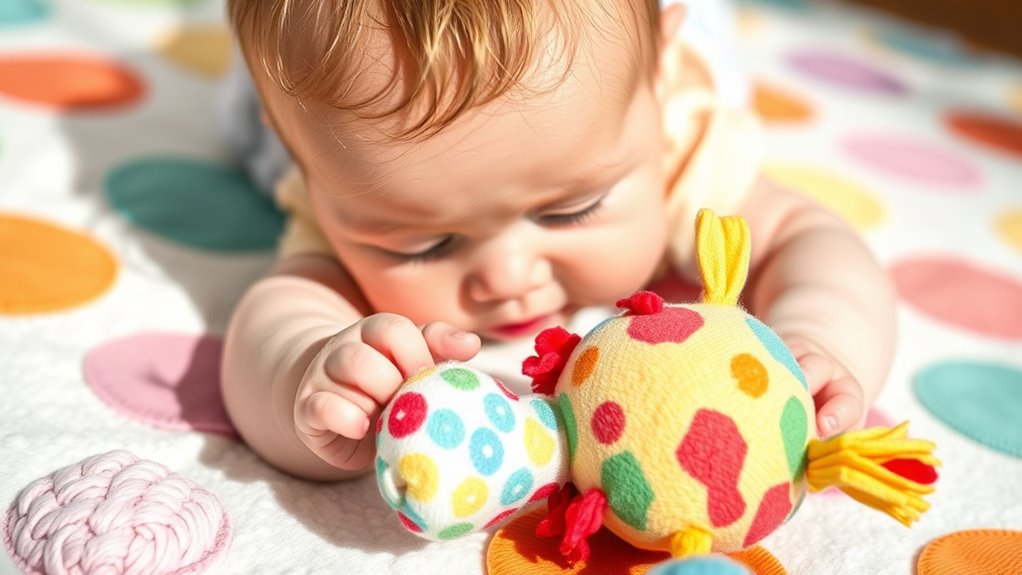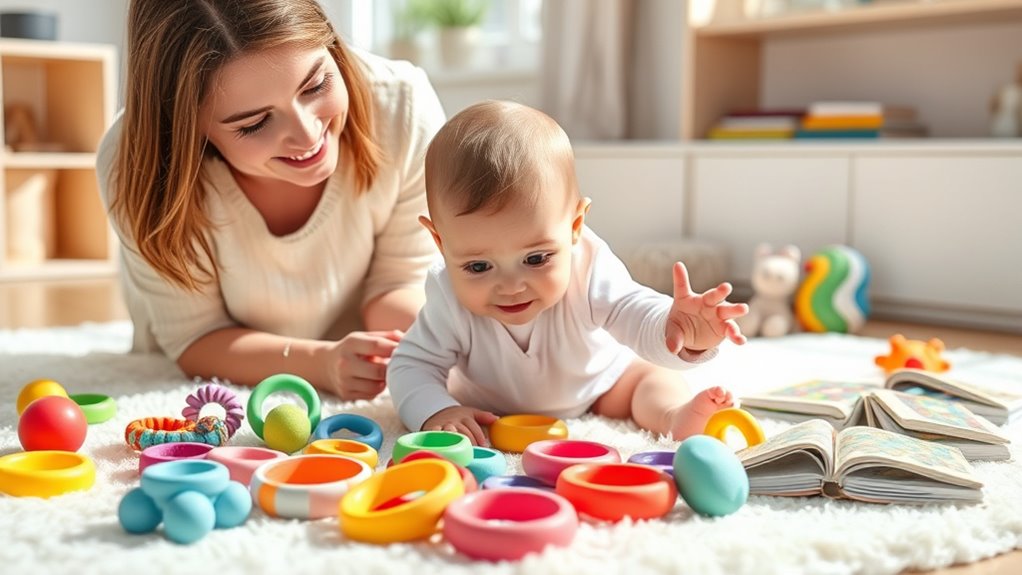To support your infant’s sensory development through play, focus on offering safe objects with different textures and sounds, like soft blankets, crinkly paper, or jingling toys. Incorporate activities such as singing, gentle clapping, or describing textures aloud to encourage exploration. Creating a consistent, safe environment helps your baby build curiosity, fine motor skills, and neural connections. Keep exploring these simple techniques, and you’ll discover even more ways to nurture their growth and learning.
Key Takeaways
- Incorporate diverse textured objects and sounds into daily play to stimulate tactile and auditory senses.
- Use singing, clapping, and gentle music to engage infants’ auditory development during activities.
- Create a safe, comfortable environment that encourages exploration and consistent sensory routines.
- Describe textures and sounds aloud to reinforce language skills alongside sensory experiences.
- Supervise activities to ensure safety, turning everyday moments into opportunities for sensory learning.

Have you ever wondered how to best support your baby’s sensory development? One of the most effective ways is through engaging in simple, intentional play that encourages tactile exploration and auditory stimulation. From the moment your baby is born, they’re naturally enthusiastic to touch, feel, and listen to the world around them. By providing them with opportunities to explore different textures and sounds, you help build their sensory foundation, which is essential for their overall growth and learning.
Supporting your baby’s senses through simple, playful exploration fosters growth, curiosity, and lifelong learning.
Start by offering a variety of safe objects with different textures—soft blankets, bumpy rubber toys, smooth wooden blocks, or crinkly fabrics. As your baby touches and manipulates these items, they engage in tactile exploration, which helps develop their sense of touch and fine motor skills. Don’t be afraid to introduce new textures regularly; each new sensation stimulates their curiosity and enhances their ability to differentiate between different surfaces. As you do this, talk to your baby about what they’re feeling. Describe the textures aloud, saying things like, “This blanket is soft,” or “This toy is bumpy.” This not only reinforces their tactile sense but also introduces them to language and vocabulary.
Auditory stimulation is equally important. You can incorporate this by singing songs, clapping, or playing gentle music during playtime. Voice interactions, such as talking or reading to your baby, expose them to a rich variety of sounds, helping sharpen their listening skills. When you introduce different sounds—perhaps the crinkle of a paper or the jingle of keys—you engage their auditory senses and support their ability to distinguish between sounds. These activities are especially effective because they combine auditory and visual cues, making the experience more engaging and memorable for your little one.
Consistency is key. Creating a routine where tactile and auditory experiences are part of daily playtime allows your baby to anticipate and enjoy these sensory activities. Keep the environment safe and comfortable, and always supervise play to prevent choking hazards or injuries. Remember, the goal is to foster a positive and stimulating environment that encourages your baby’s natural curiosity. As they explore textures and sounds, they’re not just developing their senses—they’re also building critical neural connections that support future learning, language development, and emotional security. With patience and avid interest, you can turn everyday moments into rich sensory adventures that set the foundation for your baby’s lifelong learning journey.
Frequently Asked Questions
When Should I Start Sensory Play With My Infant?
You can start sensory play with your infant as early as 0-3 months old. During this stage, they begin reaching infant milestones like grasping and tracking objects, making sensory exploration essential. Use safe, simple items like soft fabrics or textured toys to stimulate their senses. As they grow, you can introduce more varied textures and sounds, encouraging further development and strengthening their curiosity through playful exploration.
How Can I Tell if My Infant Is Overstimulated?
If your infant shows signs of sensory overload or overstimulation, you’ll notice fussiness, turning away, or rubbing their eyes. They might become irritable, arch their back, or seem overwhelmed by sounds, lights, or textures. To help, reduce sensory input, create a calm environment, and give them breaks from stimulation. Watching for these overstimulation signs helps you respond quickly and comfort your baby effectively.
Are There Safety Concerns During Sensory Play?
During sensory play, safety is key. You should always watch for choking risks from small objects and avoid materials with chemical hazards like toxic paints or cleaners. guarantee play areas are clean and free of sharp edges. Use age-appropriate, non-toxic materials, and supervise your infant closely to prevent accidents. Regularly inspect toys and supplies for damage, and remove anything that could pose a choking or chemical hazard.
What Are Low-Cost Sensory Play Ideas?
Looking to dazzle your little one without draining your wallet? You’re in luck! Budget-friendly ideas for sensory activities include homemade textured bottles, playing with rice or pasta, or exploring natural elements like leaves and stones. These simple, cost-effective sensory play ideas keep your infant engaged and help develop their senses, all without splurging. Who knew that supporting infant development could be so inexpensive and fun?
How Does Sensory Play Support Developmental Milestones?
Sensory play supports your infant’s developmental milestones by encouraging tactile exploration and auditory stimulation. As you provide activities like textured toys or musical sounds, your baby improves their fine motor skills, enhances their ability to recognize different sensations, and develops early language skills. These experiences boost their curiosity, strengthen neural connections, and help them better understand their environment, laying a strong foundation for future growth and learning.
Conclusion
By engaging your baby in thoughtful play, you’re planting the seeds for a vibrant garden of sensory growth. Every touch, sound, and sight becomes a brushstroke on their developing canvas, shaping their understanding of the world. Remember, you’re the guiding star illuminating their path to discovery. Your gentle encouragement transforms simple moments into powerful building blocks for their future—like a warm sun nurturing a delicate flower, your love helps their senses blossom beautifully.









